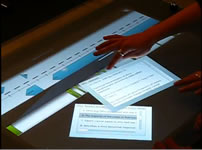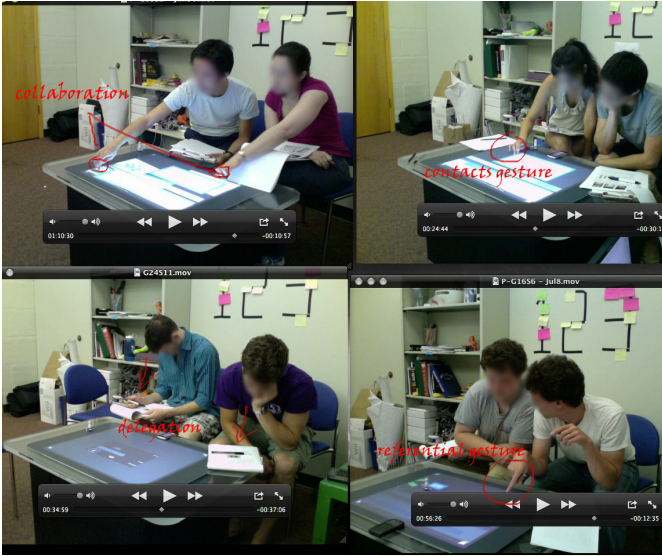G-nome Surfer: Enhancing Scientific Discovery through Reality-Based Interaction



Team:
Orit Shaer, Megan Strait, Consuelo Valdes, Michael Lintz, Taili Feng, Heidi Wang, Catherine Grevet, Chloe Fan, Sarah Elfenbein, Guy Kol
Publications:
- C. Valdes, D. Eastman, C. Grote, S. Thatte, O. Shaer, A. Mazalek, B. Ullmer, M. Konkel. Exploring the Design Space of Gestural Interaction with Active Tokens through User-Defined Gestures. ACM CHI 2014 (Acceptance Rate 23%). Best Paper Award Honorable Mention [Awarded to top 5%].
- O. Shaer, A. Mazalek, B. Ullmer, M. Konkel. From Big Data to Insights: Opportunities and Challenges for TEI in Genomics. Tangible, Embedded and Embodied Interaction, February 2013.
- O. Shaer; C. Valdes. A Tiered Evaluation Framework for Reality-Based Creativity Support Environments. CHI'13, 2013.
- O. Shaer, M. Strait, C. Valdes, H. Wang, T. Feng, M. Lintz, M. Ferreirae, C. Grote, K. Tempel, and S. Liu. The Design, Development, and Deployment of a Tabletop Interface for Collaborative Exploration of Genomic Data. Int J of Human-Computer Studies, May 2012.
-
O. Shaer, M. Strait, C. Valdes, T. Feng, M. Lintz and H. Wang. G-nome Surfer: a Tabletop Interface for Collaborative Exploration of Genomic Visualization. BioVis IEEE symposium on biological data visualization, October 2011.
O. Shaer, M. Strait, C. Valdes, T. Feng, M. Lintz and H. Wang. Enhancing Genomic Learning through Tabletop Interaction, Proc. ACM CHI 2011. - O. Shaer, G. Kol, M. Strait, C. Fan, C. Grevet and S. Elfenbein. G-nome Surfer: a Tabletop User Interface for Collaborative Exploration of Genomic Data. Proc. ACM CHI 2010.
Media:
- BioInform: The Integrated Informatics News Source - Wellesley Genome Browswer Uses Touch Technology to Enable Interactive Visualization of Sequence Data
Project Brief:
In this National Science Foundation-funded project, we will design, develop and evaluate G-nome Surfer, a tabletop user interface for collaborative exploration of genomic information. G-nome Surfer will be designed to facilitate collaborative, immediate and fluid interaction with large amounts of heterogeneous genomic information. It will lower the threshold for using advanced bioinformatics tools and will reduce the syntactic mental workload associated with bioinformatics tasks.
The main research question this project attempts to answer is how tabletop reality-based interaction can support collaborative research and facilitate new discoveries. Specifically, we address two questions: What is the key computational functionality required to enable an effective use of a tabletop reality-based interface for genomic research? And, can reality-based interface improve users' workflow and facilitate the development of new biological insights?
The outcome of this project will contribute to four areas of current research:
- Tabletop and tangible human-computer interaction
- Visualization of large scientific databases
- Computer supported collaborative learning
- Usability guidelines for bioinformatics tools





